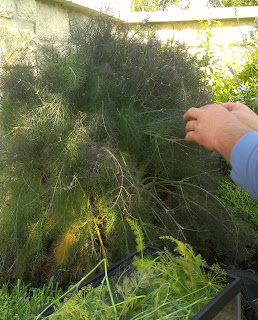Meanwhile, a fun new "project" has come along lately that I thought you might enjoy: eastern black swallowtail caterpillars!
We started noticing the caterpillars on our lone dill plant in early June. LOTS of them.
Everything was cool until they started turning black and dying, one by one. Finally, I saw a spined soldier bug (stink bug) killing one. And then another. And then several more.
Predatory stink bugs can be helpful because they eat pest caterpillars and many other undesirable insects. But they don't care that we think swallowtail butterflies are pretty. So Byrd and I decided to remove the caterpillars to a safe place, and let the stink bugs find something else to eat.
We ended up with 34 caterpillars in various stages of growth. But where were we going to keep all of these caterpillars?
So Byrd, in true Byrd fashion, went way overboard and built them a fancy caterpillar castle.
First was the base. It is plywood and wood trim that rests on a big square plastic pot. In the four corners, he made four little vases out of PVC. In the middle is a big hole.
Dozer didn't understand what we were up to, but he enjoyed laying on the garage floor and getting the occasional hug and baby talk.
 |
| "What d'ya mean, 'who's your sweet bubby boy'? Is that a rhetorical question?" |
Though the garage is still kind of new for all of us, Dozer makes a really great "garage-buddy" dog. He finds a comfy spot on the floor and just hangs out there. Even if the garage door is wide open and someone's walking past the house (with their dog, even), he doesn't care at all. Just sits there.
Next, Byrd made the top part, and wrapped it with window screen wire. You can see the underside of the plywood, where the PVC vases are screwed in.
So what's that big hole for? It's for a potted plant that the caterpillars can eat. I wanted to be able to swap out the plant that goes in the middle, depending on what was available.
Swallowtail caterpillars eat plants in the wild carrot family: dill, fennel, parsley, and Queen Anne's lace.
We only have the one dill plant, and because it's later in the summer now, dill isn't available at the nurseries. Parsley is in season, however. So we bought a whole bunch of parsley and put them into pots that would sit in the center hole.
Here's what the caterpillar castle looked like right after we put all our caterpillars in.
Live young parsley plants are, frankly, too expensive to keep buying every day. After we ran out of live parsley on the fourth day, I bought some bunches of organic parsley from the grocery store.
At 99 cents for a bunch that lasts a few days, I can live with it. And the caterpillars don't seem to mind. I just trim the stems and pop the parsley into the PVC vases.
Today, we only have 1 of these 34 caterpillars still as a caterpillar. The rest have turned into chrysalides!
Some of the caterpillars pupated on the screen of the castle.
And some of them found a spot on the wood. Swallowtail chrysalides are either green or brown, and it seems that they try to pick the color that matches most closely to the surface where they settle down to pupate. Camouflage!
We had a problem with about 10 of the pupas; the caterpillars decided to use a parsley stem. In the wild, it would probably be okay for a caterpillar to pupate on a fairly sturdy stem, but our parsley was cut, and it started to wilt.
The droopy parsley stems cause the chrysalis to hang upside down, which isn't good for it. We had to zip-tie the wilty stems on to a stick, so the chrysalides can stay upright until the butterflies are ready to emerge.
They'll spend about 2 weeks in the chrysalis before emerging as big Swallowtail butterflies, which we'll release into our garden. The good thing about chrysalides is that they don't eat/poop constantly.
So we're almost done with Caterpillar Batch 1.
Now comes Batch 2!
Last Saturday, Byrd and I watched a swallowtail butterfly neatly place tiny little green eggs on the dill plant.
In four days, the eggs hatched into microscopic black caterpillars.
I tried to get a picture of one. Can you see it there? This is a two-day-old eastern black swallowtail caterpillar. It is at a stage called "first instar." Instar is the stage of the caterpillar's growth.
When the first instar caterpillar sheds its skin, it becomes second instar. Swallowtail caterpillars go through four instars before pupating.
I wanted to leave the caterpillars on the dill plant for as long as possible. But today, most of the caterpillars had reached second instar, and they were starting to get eaten by soldier bug nymphs, which look like tiny, bright red beetles.
So I removed the little caterpillars to one of our aquariums.
I counted approximately 55 caterpillars in Batch 2!
Can you see the difference between first and second instar? These caterpillars have shed their skin once, and now have more orange color.
We will probably keep these little guys in the tank for the first week. When they're larger, we'll move them into the caterpillar castle.
Hopefully, by then, Batch 1 will be butterflies.
But that's not all. Today we saw another swallowtail butterfly laying her eggs all over the dill! In another week, we will have Batch 3. :O
By the end of summer, we'll probably have raised and released over 100 butterflies. Totally worth it!
Here's a random shot of Star, since she didn't get to be in this blog post for any other reason. She had some crazy upright ears going on.
 |
| "What're YOU looking at?!" |






















































